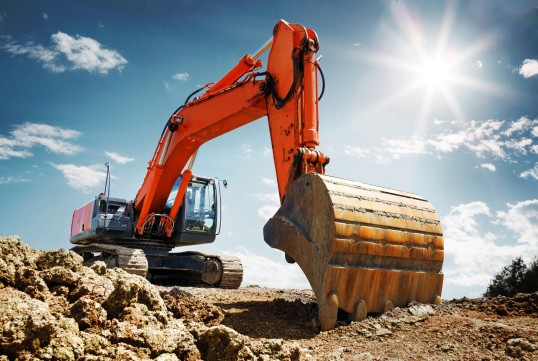- Artificial Intelligence (AI)
- Occupational exposure limit values
- Climate Change and Occupational Safety
- List of CMR substances
- Electromagnetic fields
- Ergonomics
- Industrial Security
- Collaborative robots
- Noise
- Nanoparticles at the workplace
- Optical Radiation
- REACH
- Reference materials
- Proficiency testing
- Vibration
- Virtual reality
- Work 4.0
CCTV systems on construction machinery

During work involving hydraulic excavators, the danger zones behind and beside the machine must be monitored during reversing and rotating movements.
Source: Petair, Stock.Adobe
Digital media such as camera systems and monitors are often used in order to facilitate work tasks, for example on construction machinery. Whether such technology-assisted man-machine interfaces enhance safety and health at work or are associated with risks of their own is a question that must be answered by prevention research.
Construction machinery in general and hydraulic excavators in particular have undergone a range of technical further developments in recent years aimed at optimizing the human-machine interface and thus enhancing safety. These changes include improvements to the visibility of the surroundings from the driver's cab, for example by means of additional viewing aids. CCTV systems for example enable the operators of the machinery to view obstructed parts of the danger zone, in order to be able to avoid collisions with persons or objects. This is particularly relevant during travel and rotating movements on hydraulic excavators, since the direct view of the areas to the rear and sides is frequently obstructed.
ISO 5006 sets out requirements concerning the direct and indirect view from the driver's cab on earthmoving machinery. Aids to vision such as mirrors and CCTV systems can be used in order to satisfy these requirements. It has not been established however how these viewing aids and other sources of information are actually used by the machine operators during their everyday work. This is important for assessment of the extent to which these systems are able to support safe and efficient operation of the machines. The IFA was therefore tasked by the German Social Accident Insurance Institution in the building trade (BG BAU) with conducting eye-movement tracking and observation interviews with experienced machine operators during real-case operations on construction sites. Based upon the results of eye tracking during selected travel movements, it was possible to assess the use and acceptance of viewing aids on hydraulic excavators. Frequent use of a viewing aid is a general indicator of its usefulness. Conversely, less frequent use may indicate design characteristics that make use by the machine operator more difficult, or make use appear less worthwhile. Improved design of the viewing aids concerned could contribute here to their use being increased and to safety on construction sites being improved as a result.
Where viewing aids are used on construction machinery, consideration must always be given to further factors that have an impact upon machine operators' attention, perception, comprehension and behaviour. Besides the work task and the work environment, these factors include modern forms of work equipment that display further information, such as GPS systems, and sensors and warning systems for collision avoidance and distance monitoring.
This study delivers preliminary information that can be used to assess the use made of viewing aids. Finally, recommendations are to be formulated based upon these and further results for improvements to the design of operators' cabins on construction machinery in order to improve safety on construction sites.
Further information

Contact
Accident Prevention: Digitalisation - Technologies
Tel: +49 30 13001-3514Fax: +49 30 13001-38001